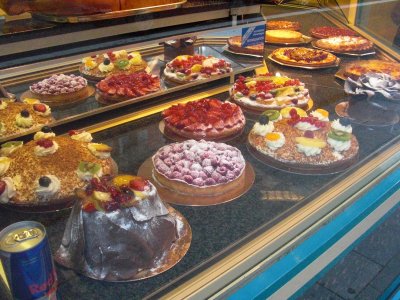
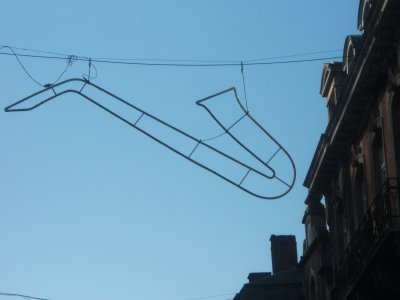 The pastry-shop windows were particular breautiful, and at intervals overhead were strung these illuminated saxophones (each consisting of yellow plastic tubing lit from within (during the evening) by a string of tiny white lights. Walking north, past the citadel and the church, we encountered several other saxophone-themed sculptures, of various degrees of realism or abstractness (in addition to the disks set into the sidewalk commemorating the most recent saxophone festival, back in the 1990s, and the music-themed grills protecting the roots of the street trees.
The pastry-shop windows were particular breautiful, and at intervals overhead were strung these illuminated saxophones (each consisting of yellow plastic tubing lit from within (during the evening) by a string of tiny white lights. Walking north, past the citadel and the church, we encountered several other saxophone-themed sculptures, of various degrees of realism or abstractness (in addition to the disks set into the sidewalk commemorating the most recent saxophone festival, back in the 1990s, and the music-themed grills protecting the roots of the street trees.
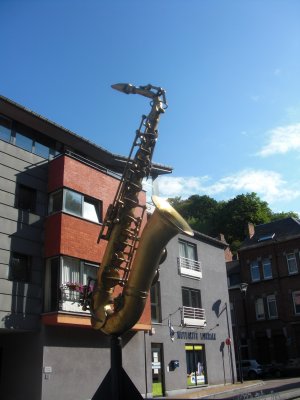
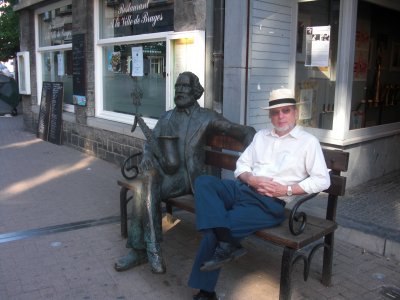 At the northernmost point of our stroll, we came to the town's official monument to the saxophone, which is about 12 feet high (excluding the pedestal) and is made, of course, of dinanderie. On the way back, down a different street, we chanced on the house where Adolphe Sax was born (and the adjacent museum). Here David shares a bench with that august personage, although he seems to have forgotten his saxophone. [Note added later: I have since learned that a web cam is trained on this bench. Check it out at http://www.dinant.be/index.htm?lg=1&m1=2&m2=171; it refreshes every 15 seconds.]
At the northernmost point of our stroll, we came to the town's official monument to the saxophone, which is about 12 feet high (excluding the pedestal) and is made, of course, of dinanderie. On the way back, down a different street, we chanced on the house where Adolphe Sax was born (and the adjacent museum). Here David shares a bench with that august personage, although he seems to have forgotten his saxophone. [Note added later: I have since learned that a web cam is trained on this bench. Check it out at http://www.dinant.be/index.htm?lg=1&m1=2&m2=171; it refreshes every 15 seconds.]
Promptly at 10 a.m., we presented ourselves at the foot of the cliff for the cable-car ride to the citadel and were dismayed to see the two tour buses pull up, then even more dismayed to see the crowds of school children emerge from them. Ah, good, they're assembling on the church steps—they'll visit the church first, then join the tour after ours. We rode up in the first cable-car of the day (capacity 17 people, less than a minute's travel time) and made a bee-line for the tour assembly area, only to learn that the tour didn't actually start until 10:30 a.m. So there we were with another half hour to wait, so David sat down in the café with a cup of tea while I walked across the courtyard to explore the one-room museum of the Belgian national school for noncommissioned officers, which I gathered from photos in the museum is in the shadow of the huge highway viaduct that crosses the river gorge south of town.
The museum was interesting mainly for its insight into what it means to be a noncom; I had never thought about there being a special school for them. A framed sort of leadership credo on the wall read, "If you slow down, they will stop; if you sit down, they will lie down . . . ; if you lead, they will overtake you; if you give your all, they will surpass you; . . . ." Even more interesting to me was the exhibition of field-ration kits, which contained flat, oval cans (with pop tops) of "chicken à la Parisienne" and "boeuf bourguignon" and smaller round cans of pork rillettes and vache-qui-rit cheese (with accompanying crackers).
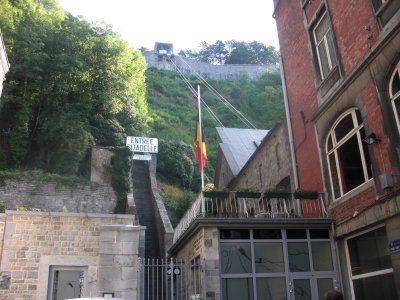
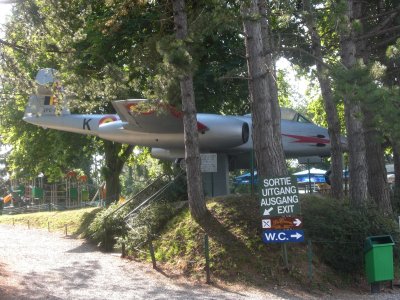 Here's the view from the bottom of the cable-car line. If you don't want to ride, you can, instead, climb the 400-odd stone steps up the cliff face. At the top is this old airplane, mounted on a pedestal among the trees. I was glad finally to get a photo of one—the rotary nearest each of the military bases we'd driven past typically featured an airplane on a pedestal, but they tended to go by too fast for photography.
Here's the view from the bottom of the cable-car line. If you don't want to ride, you can, instead, climb the 400-odd stone steps up the cliff face. At the top is this old airplane, mounted on a pedestal among the trees. I was glad finally to get a photo of one—the rotary nearest each of the military bases we'd driven past typically featured an airplane on a pedestal, but they tended to go by too fast for photography.
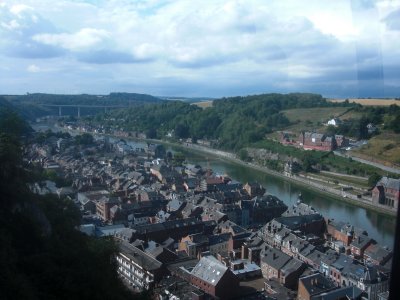
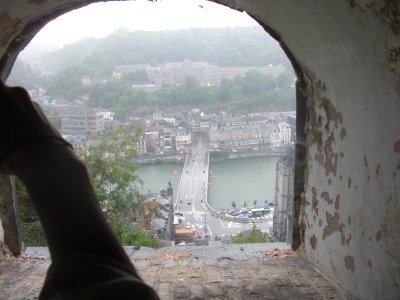 Here are two views from the citadel, one looking south (left; you can see the viaduct in the distance) and one looking west, in which you can see, front and center, the bridge from which, in 1466, Charles le Téméraire (yes, Charles the Pushy, Duc de Bourgogne, making a nuisance of himself again) had 800 citizens, predominantly coppersmiths, bound, tied together in pairs, and thrown into the Meuse in punishment for some local uprising. It wasn't all his idea; his father, Philippe le Bon (yes, Philip the Good; nice guy) contributed.
Here are two views from the citadel, one looking south (left; you can see the viaduct in the distance) and one looking west, in which you can see, front and center, the bridge from which, in 1466, Charles le Téméraire (yes, Charles the Pushy, Duc de Bourgogne, making a nuisance of himself again) had 800 citizens, predominantly coppersmiths, bound, tied together in pairs, and thrown into the Meuse in punishment for some local uprising. It wasn't all his idea; his father, Philippe le Bon (yes, Philip the Good; nice guy) contributed.
Louis XIV conquered Dinant on one of his many campaigns, so the original fortifications on the site were, of course, remodeled and refortified by Vauban (the man was everywhere), but those fortifications were dismantled when the area reverted to the principality of Liège a few years later, and the present citadel built on the site. It's main purpose was to protect and control the bridge (the one Charles threw people off)—at the time, there wasn't another bridge for 30 km on either side, and Dinant was on the road between Cologne and Paris—pretty strategically important.
At last the guide appeared, and we and a dozen other folks followed him to the initial stop on the tour, where we were joined (aargh!) by the whole two bus-loads of 6-, 7-, and 8-year-olds—110 of them by actual count (getting them all up there in 17-person cable-car loads must have taken the whole half hour!). They were in some sort of summer-camp program that took them off on field trips to places like Dinant. Two factors, however, saved the tour and made it a truly memorable one. First, our guide was brilliant at his job. He started by marshalling us all into optimal formation ("Adults along the side walls, please, and young ones in the center; we'll do it this way at each stop"). Second, as the guide was calling for attention, amid a babble of excited children, the chief camp counselor stopped him with a raised finger, took a deep breath, and shouted "Allo!-Allo!," to which the urchins instantly responded with a shout, in ringing unision, of "J'écoute!" ("I'm listening!") followed by dead silence. We were stunned, as were the guide and all the other adults. Wow. They must have spent the first three days of camp just drilling them on that one wonderful maneuver.
Written 4 August 2010
Once we'd all blinked about three times and closed our mouths, the guide started by addressing the kids, whom he called "petits loups" (young wolves; whelps), explaining that he was going to have to ask them for a huge amount of patience. Some of his remarks would be addressed to them, and others would be intended for the grown-ups. On top of that, he would have to spend some time repeating his explanations in Dutch, for the Flemish grown-ups (the whelps spoke French). Could he count on them to be considerate as well as patient? Yes, they assured him, he could. Excellent.
He was really, really good at it. He clearly had lots of practice addressing school groups and knew just how to engage the kids' attention and to tailor his explanations to them. Every few minutes he'd state a fact and warn they'd be quizzed on it later. ("Okay, here's a diorama of Charles le Témérarire; how many citizens did I tell you he threw in the river? 800, right! I knew I could count on you." Then ". . . and the special gun with a bell-shaped barrel that shot many bullets at once; what was that called? A tromblon; very good—what clever and attentive whelps you are!"). Then seemlessly, he'd segue into the more advanced information for the grown-ups, in two languages, and get back to the kids before they got too restless. I asked at one point whether "petits loups" were some sort of scouting organization, but no, it's apparently just a common affectionate name for little kids in Belgium (and perhaps elsewhere were French is spoken)—I later encountered it in a couple of restaurants, where the kid's menu was headed "Pour les Petits Loups."
Written 5 Augsut 2010
The citadel is quite large, so it houses several different "museum zones." We visited a series of rooms set up as dioramas of historical events that took place there (Vauban planning his fortifications, etc.); a section with another series of rooms furnished and populated by costumed mannekins to demonstrate the bakery, butchery, kitchens, and forge that were housed there when the citadel was manned by a garrison of 400; the dead-end tunnel where a contingent of French troops were trapped and massacred by a group of Germans during WWI (more costumed mannekins, this time armed and dangerous); a museum of weapons; many kinds of mounted cannons; a recreation of WWI trenches, with flashes and sound effects; and a reconstruction of a tilted bunker. The guide stopped at this point and emphasized for all of us, and especially for the petit loups, that this bunker was a reconstruction representing an actual event during WWI but it didn't actually happen here. An underground concrete bunker was struck by a bomb large enough to tilt the whole thing at abouta 20- 30-degree angle but leave it intact. We got to walk through it, and both the guide and prominent posters near the entrance warned that it would be weird and disorienting—and boy was it! Much more so than I would have expected. It's easy enough to walk on a steeply sloped hillside, because other cues help you keep track of the vertical, but in that entirely enclosed bunker, even knowing perfectly well what was happening, I kept caroming off the walls and bashing into the handrail. Strange, indeed.
The rain showers cooperated, holding off whenever we needed to go outside to get to the next segment of the tour, and the whelps were, indeed, amazingly patient and well behaved. "Allo!-Allo!" had to be invoked a couple more times, with results never quite as crisp as that first one, but the guide managed to get us through the whole thing on time and without seeming to rush. Highly, highly recommended.
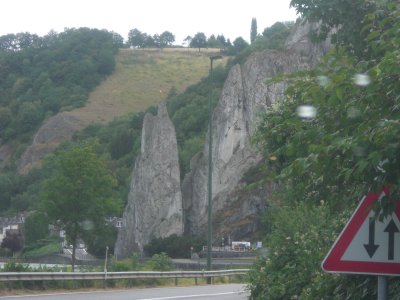 Despite the later start to the tour than we had anticipated, we had time to get back down by cablecar and walk back to the hotel by the noon check-out time. We trundled our luggage to our car, a block away in the parking lot of the casino (the hotel's had been full), and headed south out of town (just as well we were going that way anyway, as the road was one-way). Only as we passed a signpost to it did I realize that Dinant is also the location of the original Abbey de Leffe (where the famous beer originated), and just before reaching the freeway viaduct, we passed the spectacular "roche de Bayard," a huge splinter of rock split off from the cliff (legendarily broken away by the hoof of Bayard, Charlemagne's huge horse). The view is looking back north (we turned around to get a good photo of it). The northbound road passes through the declivity and the southbound one between the splinter and the river (to the left of the splinter in this view. I've got to say that Dinant set the record for ratio of interesting things we didn't have time for to things we did.
Despite the later start to the tour than we had anticipated, we had time to get back down by cablecar and walk back to the hotel by the noon check-out time. We trundled our luggage to our car, a block away in the parking lot of the casino (the hotel's had been full), and headed south out of town (just as well we were going that way anyway, as the road was one-way). Only as we passed a signpost to it did I realize that Dinant is also the location of the original Abbey de Leffe (where the famous beer originated), and just before reaching the freeway viaduct, we passed the spectacular "roche de Bayard," a huge splinter of rock split off from the cliff (legendarily broken away by the hoof of Bayard, Charlemagne's huge horse). The view is looking back north (we turned around to get a good photo of it). The northbound road passes through the declivity and the southbound one between the splinter and the river (to the left of the splinter in this view. I've got to say that Dinant set the record for ratio of interesting things we didn't have time for to things we did.
It was lunchtime, of course, so we kept our lookout for a nice restaurant, and we lucked into a real real winner, "La Clochette" (the little bell). No cultural imperialism here—the muzak was entirely in French, even the American songs, and from our era, too. We heard "If I Had a Hammer" and "Dona, Dona, Dona" in French translation, as well as covers of some Françoise Hardy that we knew.
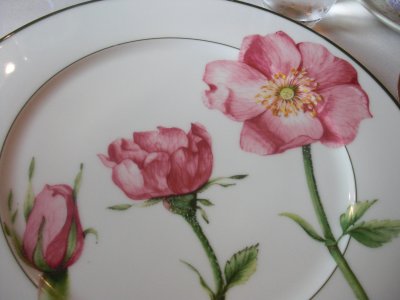
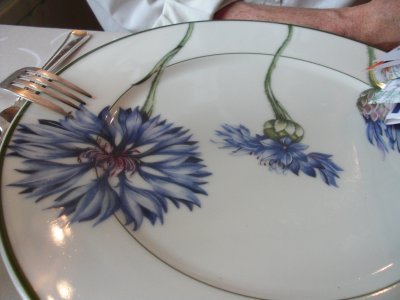 We could see the lobster tank in the lobby, and the menu specified that the trout was also straight from the tank (that one in the kitchen). The service plates were of this lovely pattern—I had the roses; David got the cornflowers. The amuse bouche was a little pot of green olives, a pair of tiny onion tarts, and a pair of rosettes of herbed cheese. While we waited for our food to arrive, someone came out of the kitchen with a large cardboard box and proceeded to transfer a dozen live lobsters from it to the tank. I took the opportunity to ask and learned that the lobsters were Canadian (explaining why they're not as expensive as the ones from France, which have become vanishingly rare).
We could see the lobster tank in the lobby, and the menu specified that the trout was also straight from the tank (that one in the kitchen). The service plates were of this lovely pattern—I had the roses; David got the cornflowers. The amuse bouche was a little pot of green olives, a pair of tiny onion tarts, and a pair of rosettes of herbed cheese. While we waited for our food to arrive, someone came out of the kitchen with a large cardboard box and proceeded to transfer a dozen live lobsters from it to the tank. I took the opportunity to ask and learned that the lobsters were Canadian (explaining why they're not as expensive as the ones from France, which have become vanishingly rare).
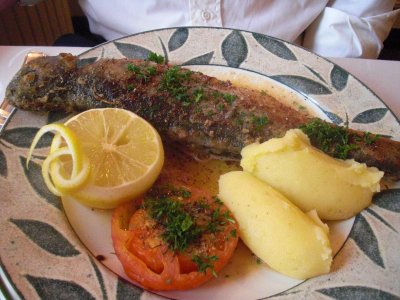
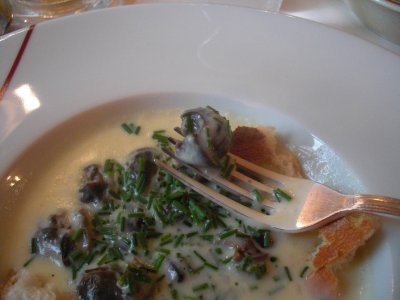 David (I was so proud of him!) ordered the trout meunière, head on and on the bone, and ate it without great difficulty and with great enjoyment. He's come a long way. I had the snails in garlic cream sauce, advertised as coming from Warnant (the very snail farm we had just visited the day before!). The reddish-brown objects are pieces of bread and dropped in to soak up the tasty sauce. We'd go back there anytime!
David (I was so proud of him!) ordered the trout meunière, head on and on the bone, and ate it without great difficulty and with great enjoyment. He's come a long way. I had the snails in garlic cream sauce, advertised as coming from Warnant (the very snail farm we had just visited the day before!). The reddish-brown objects are pieces of bread and dropped in to soak up the tasty sauce. We'd go back there anytime!
But now, time to head for Luxembourg! We were definitely out of the flat polders of western Belgium and into the Ardenne mountains. Most of the terrain was steep and wooded, and the farther east we went, the more damage we saw from the 14 July storm—whole hillsides where half the trees were snapped off jaggedly, avenues of plane trees from which half the branches had been torn. We realized just how lucky we'd been to be so far west at the time!
The forsts consisted of (that I spotted) oak, linden, beech, conifers (firs?), hornbeam, mountain ash, real ash, and sycamore maples. We saw some corn and grain in the flat spots, but mostly pasture, hay, and dairy cattle (some limousin); I spotted a few sheep and one field of caramel-brown cows (as opposed to the mostly black-and-white and cream-colored ones). Along many of the roads we saw wooden seats or platforms, like lifeguard towers, but shorter and broader; I have no idea what they were for unless they were deer-hunting stands.
David, who thinks about these things, counted ahead on his fingers and realized we'd be leaving town on a Sunday, not a good day to buy gas in Europe if you are equipped only with chipless American credit cards, which most European gas pumps don't recognize, so as we approached the city of Luxembourg, we pulled over and topped up the tank (it was still still over a third full at that point, and that was the only time we had to buy gas during the whole trip, except just before turning the car it—at that point, it was about 3/4 full, but we were supposed to turn it in full).
I expected Luxembourg to be more like Monaco than it was, but as we learned in the course of our two days there, it's actually a good deal bigger—just a shade under 100 square miles—so it has not only quite a few cities and towns but some actual countryside (as opposed to Monaco, which consists entirely of buildings, parks, pavement, and sheer vertical rock faces). In one way, it does resemble Monaco, though—its capital city is perched on a high plateau and surrounded by steep cliffs and ravines—so I knew even before we went that parking was going to be a problem. I had Google-mapped the routes from our hotel to our two restaurants (a one star and a two-star, the only Michelin-starred dinners of the trip), and back again because in steep and/or walled European cities you can never hope to retrace your steps; everything's one-way. I had therefore seen that the route to our first dinner was about half a kilometer as the crow flies but 3.5 km of switchbacks and loops by car. At one point the driving route home from the second actually crossed itself! I also knew that our hotel was squarely in the middle of a good-sized pedestrian district, so we couldn't just pull up at the curb, unload the luggage, and ask where to park. My Google maps and the Michelin city map we had acquired showed parking lots/garages as big blue P's, usually right in the middles of blocks, but gave no clue as to where the entrances might be or what the various garages were called, whereas, once we entered the city electronic signs directed us toward 8 or 10 different lots (many more than the maps indicated, and with helpful notations of the number of available spaces) but with no indications of distance or correspondence to the map. So we picked the "city center" garage, tried to follow the signs to that, and found to our exasperation that we couldn't! Three signs in succession pointed us to city center parking, straight ahead, straight ahead again (but with a drastically different number of available spaces), then left, then the next sign omitted city center altogether. Drat, we'd missed it. We went around again, picked up the same signs, followed them, and still couldn't find it. So we picked another, named for a street fairly near the hotel, and had the same problem—what does a parking garage entrance look like in this town?! Finally we pulled over and I got out to study street signs, figure out where we were, and walk to the hotel to ask for advice, as rain was beginning to fall. Within a block I'd pinpointed our location—drat, outside the city; we'd crossed a sort of causeway over the ravine without realizing it. Back to the car, turn around, try to get closer to the hotel for another try. Just then, we spotted a parking garage entrance and dived into it, quick, before we got lost again. Fortunately, it was only about four blocks from the hotel, and the rain had stopped, so we just unloaded everything and prepared to trundle it all there on foot. At which point I noticed that our license plate was hanging by one screw. Another of the screws was still in its hole in the plate, but the other two were gone completely. David tried to put the second screw back in, but the hole was stripped, so we just left it to deal with later.
The Hôtel Français was on a pleasant pedestrian square, above the Café Français; reception was on the second floor, and the tiny elevator was in the equally tiny hallway between the kitchen and the caf&meacute; tables, but after dodging several waiters with full trays we managed to get all our stuff up there. The friendly receptionist (even friendlier when he learned, to his relief, that we both spoke French and he wouldn't have to speak English) gave us the key (two keys!) to a lovely room two floors above with a view over the square and—double drat—one bed. Everything back into the elevator and down to the lobby to point out that I had plainly specified, when making the reservation, two separate beds. The receptionist was terribly embarrassed, but he didn't have such a room available; how about this one right here off the lobby, which had a very large bed, in fact two separate mattresses, but on one frame? No. Inspiration! "I could put a third bed in the room!" That we could deal with, even though, for that room, only one key was available, so he promised to order the extra bed right away, while we walked around to explore the town. I also got him to mark, on a tourist map, the walking route to our restaurant, which was actually all level, because it was up on the plateau with us.
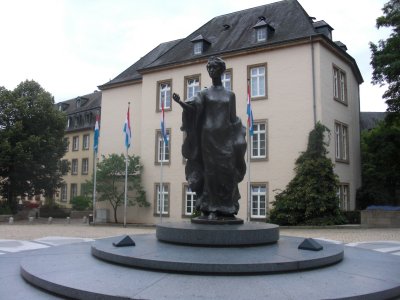
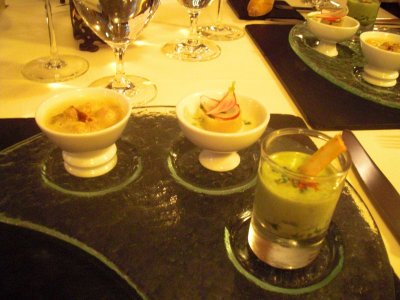 Our dinner restaurant was Clairefontaine, in the Place Clairefontaine, which was graced by this statue of Grand Duchess Charlotte (grandmother of the current Grand Duke), who abdicated in favor of her son in 1964 (after reigning for 46 years) and died in 1985. The amuse-bouche was threefold: a velout— (literally "velvety," but meaning a smooth, creamy soup) of zucchini with crispy vegetable dice in the bottom; canelloni of lobster in a beurre blanc mousse (a round slice from a long cylindrical log), and small pieces of suckling pig simmered in a mustard sauce and served over ratatouille. Somebody made a lot of money selling these crescent-shapedglass plates a few years back. We've seen them several times in different restaurants, most notably in Bordeaux, where we were served three different cheeses, one in each round depression, and the fourth, tiny depression (out of sight at the bottom of this picture) was filled with hot pepper jelly.
Our dinner restaurant was Clairefontaine, in the Place Clairefontaine, which was graced by this statue of Grand Duchess Charlotte (grandmother of the current Grand Duke), who abdicated in favor of her son in 1964 (after reigning for 46 years) and died in 1985. The amuse-bouche was threefold: a velout— (literally "velvety," but meaning a smooth, creamy soup) of zucchini with crispy vegetable dice in the bottom; canelloni of lobster in a beurre blanc mousse (a round slice from a long cylindrical log), and small pieces of suckling pig simmered in a mustard sauce and served over ratatouille. Somebody made a lot of money selling these crescent-shapedglass plates a few years back. We've seen them several times in different restaurants, most notably in Bordeaux, where we were served three different cheeses, one in each round depression, and the fourth, tiny depression (out of sight at the bottom of this picture) was filled with hot pepper jelly.
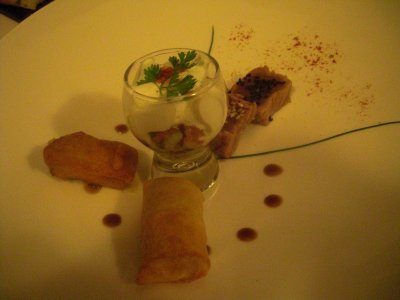
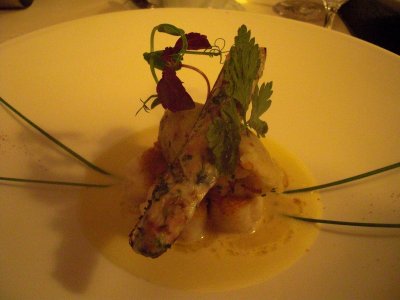 We both chose the menu. The first course of which was a "declension of red tuna": a piece "confit" at low temperature, a glass of raw cubes with a creamy lemon sauce, a "coriander crispy," and a tandoori fritter. The raw cubes were the best and the low-temperature treatment the least interesting. We've been very pleased with many low-temperature treatments of meat and eggs, but it just doesn't do much for tuna. Next came French sole "de petit bateau" grilled and then balanced on top of a trio of seared scallops, Charlotte potatoes, and peasant bacon, and topped with a "couteau en gratin." It was all good, but the couteau (a long skinny bivalve, a razor clam?) was outstanding. it had been removed from its shell, diced, sauced, returned to the half-shell, browned under the broiler, and then balanced across the top of the fish. The whole thing was stuck about with tall, curly pea sprouts. As you can see, this chef likes his food tall.
We both chose the menu. The first course of which was a "declension of red tuna": a piece "confit" at low temperature, a glass of raw cubes with a creamy lemon sauce, a "coriander crispy," and a tandoori fritter. The raw cubes were the best and the low-temperature treatment the least interesting. We've been very pleased with many low-temperature treatments of meat and eggs, but it just doesn't do much for tuna. Next came French sole "de petit bateau" grilled and then balanced on top of a trio of seared scallops, Charlotte potatoes, and peasant bacon, and topped with a "couteau en gratin." It was all good, but the couteau (a long skinny bivalve, a razor clam?) was outstanding. it had been removed from its shell, diced, sauced, returned to the half-shell, browned under the broiler, and then balanced across the top of the fish. The whole thing was stuck about with tall, curly pea sprouts. As you can see, this chef likes his food tall.
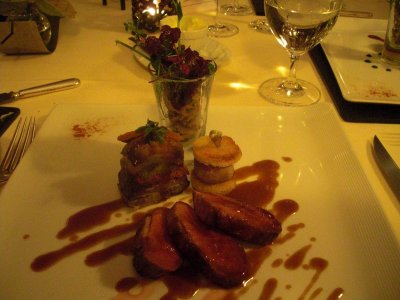
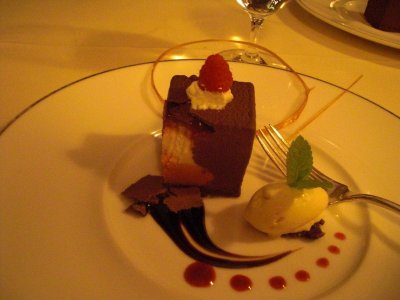 Next came rare grilled duck breast, accompanied by a slice of stacked ratatouille, a small piece of sautéed duck liver, and the boned and shredded braised duck leg, tossed with a vinaigrette and served with some salad in a tall parfait. glass. Deelish!
Next came rare grilled duck breast, accompanied by a slice of stacked ratatouille, a small piece of sautéed duck liver, and the boned and shredded braised duck leg, tossed with a vinaigrette and served with some salad in a tall parfait. glass. Deelish!
Dessert was described as "crisp surprise of chocolate and red fruit" and turned out to be this cube of layered fruit mousse coated in crisp chocolate and served with vanilla ice cream and sweet balsamic syrup—excellent, and for once just chocolate enough for me. It arrived at the table with the ring and spire of hard caramel standing up edgewise on top, stuck in the whipped cream (as I said, this chef likes his plates tall). When I laughed and asked the waiter "Just how many channels does this thing pick up?!" he never missed a beat, claiming they could get Paris and Berlin.
After dinner we strolled back to the hotel, at 11 p.m., only to find that nothing had been done about the extra bed. Drat. We set about rearranging furniture to make room to drag one of the matresses off onto the floor but discovered, in the process of moving it, that the odd little double-wide armless chair actually slid, unfolded, and and otherwise adjusted itself into a single bed! Simple to transfer the sheet and duvet from one of the matresses, and voilà!